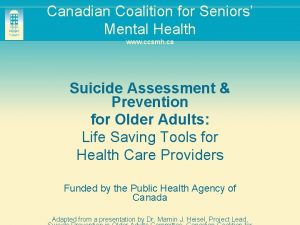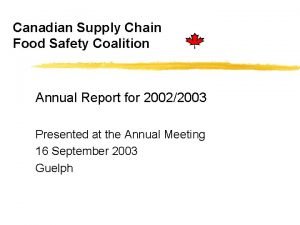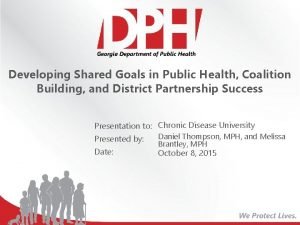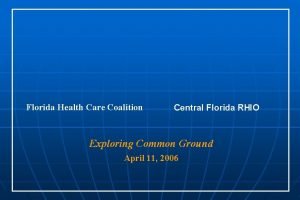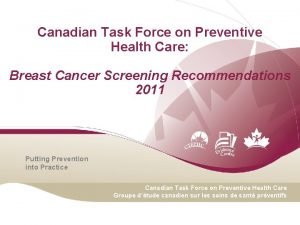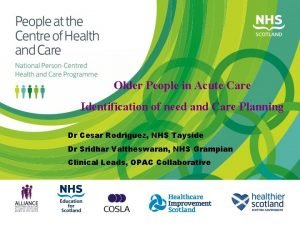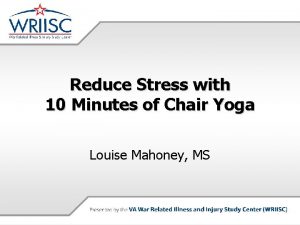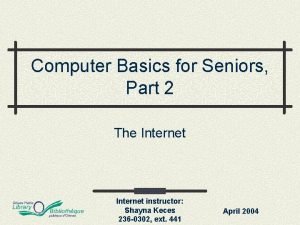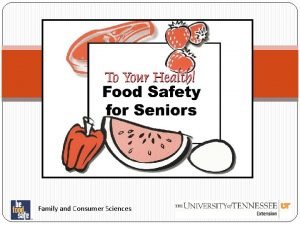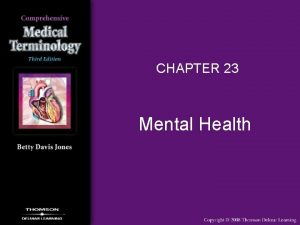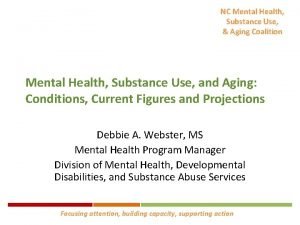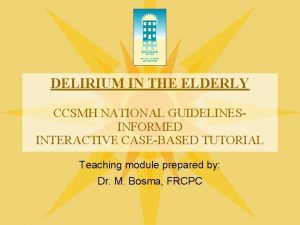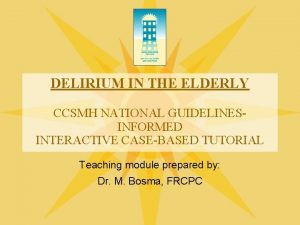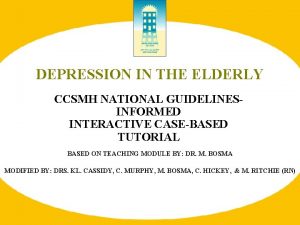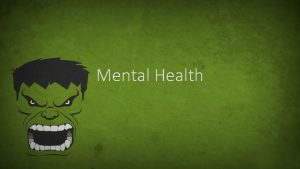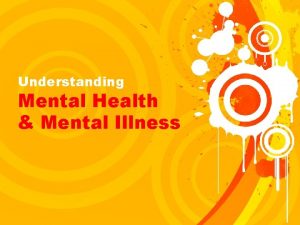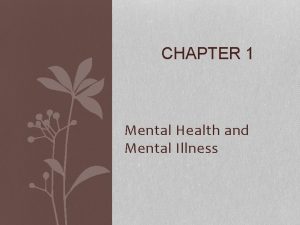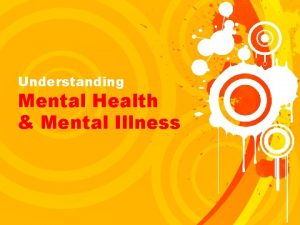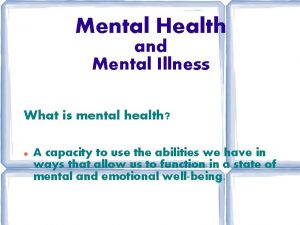Canadian Coalition for Seniors Mental Health www ccsmh

























































- Slides: 57

Canadian Coalition for Seniors’ Mental Health www. ccsmh. ca Suicide Assessment & Prevention for Older Adults: Life Saving Tools for Health Care Providers Funded by the Public Health Agency of Canada Adapted from a presentation by Dr. Marnin J. Heisel, Project Lead,

Contact Information Canadian Coalition for Seniors’ Mental Health Address: c/o Baycrest 3560 Bathurst Street Room 311, West Wing, Old Hospital Toronto, Ontario, M 6 A 2 E 1 Phone: 416 -785 -2500 ext. 6331 Fax: 416 -785 -2492 Web: www. ccsmh. ca

Contributors Dr. Martha Donnelly, MD (Project Lead) Head of the Division of Geriatric Psychiatry Department of Psychiatry University of British Columbia Dr. Marnin J. Heisel, Ph. D, C. Psych. (Project Lead and DVD Content Expert) Assistant Professor Departments of Psychiatry and Epidemiology & Biostatistics Schulich School of Medicine and Dentistry The University of Western Ontario Dr. Sharon Moore, RN, MEd, Ph. D, C. Psych. (Project Lead) Associate Professor Centre for Nursing & Health Studies Athabasca University, Alberta Charlene Foster, BA Trainer and Volunteer Coordinator London and District Distress Centre, Ontario Ian Ross, MSc Executive Director Crisis Intervention and Suicide Prevention Centre of British Columbia Joan Seabrook, MEd, SO Educational Consultant Survivor Chair, Canadian Association for Suicide Prevention Diane Yackel, MA, FT Executive Director Centre for Suicide Prevention, Alberta Sherri Helsdingen, BA Project Manager Canadian Coalition for Seniors’ Mental Health Kimberley Wilson, MSW, BASc Executive Director Canadian Coalition for Seniors’ Mental Health

Learning Objectives By the end of this workshop, you will be able to: § Demonstrate a basic understanding of the epidemiology of late life suicide; § Be aware of the risk factors for suicide, as well as protective factors; § Identify suicide warning signs; § Initiate life-saving conversations about depression and suicide risk using key questions to assess for suicide risk; § Be familiar with late-life suicide risk assessment and clinical intervention strategies; § Integrate components of the CCSMH Late Life Suicide

Epidemiologic Considerations § The World Health Organization estimates that approximately One Million lives are lost to suicide worldwide every year. § Suicide is a leading cause of preventable death that accounts for more deaths annually than homicide and war combined. § Every death by suicide leaves at least 6 survivors. § Suicide is a leading cause of preventable morbidity and mortality worldwide.

World Health Organization (WHO) Data

The Epidemiology of Late Life Suicide § Older adults have high rates of suicide worldwide, including in Canada and the U. S. § There are currently over 4. 3 million Canadians aged 65 years and older. § 1 out of every 7 Canadians is a senior citizen. In 2006, seniors accounted for a record high of 13. 7% of the total population. § Between 2006 and 2026, the number of seniors is projected to increase from 4. 3 million to 8. 0 million. Their share of the population is expected to increase from 13. 2% to 21. 2%. § “Baby boomers” have high rates of suicide.

Reality: Seniors (by age sub-groups) as % of the Total Population Canada, 1921 -2041 25 65 -74 75 -84 85+ Percentage 20 15 10 5 0 1921 1931 1941 1951 1961 1971 1981 1991 2001 2011 2021 2031 2041 Year

Mortality Statistics § Demographic risk factors include sex (Male), age (Older), and ethnicity (Caucasian/White). § In 2004, 427 Canadians 65+ died by suicide, including 319 men and 108 women. § Men between 85 and 89 years of age had a suicide rate (26. 8/100, 000) that more than doubled the national average of approximately 13/100, 000. § Suicide mortality data underestimate “true” suicide rates, and do so differentially.

2004 Stats. Can Suicide Rates (per 100, 000)

Mortality Statistics § The ratio of suicidal behaviour to deaths for older adults is between 1 -4: 1, while that for adolescents is as high as 200 -300: 1 § Many older adults may end their lives by refusing food and / or needed medications; however, these deaths are typically not officially deemed suicides. § Means of suicide differ by age, gender, and location. § Detection of suicide risk in older adults is crucial; interventions can then follow.

Suicide Prevention Among Older Adults § Barriers exist to effective risk detection and intervention. § Until recently, one such barrier was the absence of practice guidelines for suicide risk assessment and interventions for older adults. § CCSMH recently released 4 federally funded (Public Health Agency of Canada) National Guidelines for the care of mental health issues affecting older adults: • Assessment and Prevention of Suicide • Delirium • Depression • Mood and Behavioural Problems in Long-term Care Homes

CCSMH Late Life Suicide Prevention Toolkit § CCSMH National Guidelines for Seniors’ Mental Health: The Assessment of Suicide Risk and Prevention of Suicide § Clinician pocket-card - Suicide: Assessment & Prevention for Older Adults § DVD - Suicide Assessment & Prevention for Older Adults: Life Saving Tools for Health Care Providers

Suicide Assessment & Prevention for Older Adults: Warning Signs Q: What are the warning signs that someone is at risk for suicide?

Suicide Assessment & Prevention for Older Adults: Warning Signs Remember “IS PATH WARM? ” – I Ideation – S Substance Use – P Purposelessness – A Anxiety/Agitation – T Trapped – H Hopelessness/Helplessness – W Withdrawal – A Anger – R Recklessness – M Mood Changes From the American Association of Suicidology (AAS) website (www. suicidology. org).

Suicide Assessment & Prevention for Older Adults: Risk Factors Q: What are the risk factors for suicide?

Suicide Assessment & Prevention for Older Adults: Risk Factors 1. Suicidal Ideation and / or Behaviour § Prior suicidal behaviour (including suicide attempt), prior self-harm behaviour, previous expression of suicide ideation § Feels tired of living and/or wishes to die § Thinks about suicide, has suicidal wishes and / or desires § Has a suicide plan / note 2. Family History § Family history of suicide, suicide ideation, mental illness

Suicide Assessment & Prevention for Older Adults: Risk Factors 3. Mental Illness (can include) § Any mental disorder, co-morbidity § Major depressive disorder § Any mood disorder § Psychotic disorder § Substance misuse disorder / addictions 4. Personality Factors § Personality disorders § Emotional instability § Rigid personality § Poor coping skills, introversion

Suicide Assessment & Prevention for Older Adults: Risk Factors 5. Medical Illness § Pain, chronic illness § Sensory impairment § Perceived or anticipated / feared illness 6. Negative Life Events and Transitions § Family discord, separation, death or other losses § Financial or legal difficulties § Employment/retirement difficulties § Relocation stresses 7. Functional Impairment § Loss of independence § Problems with activities of daily living

Suicide Assessment & Prevention for Older Adults: Resiliency Factors Q: What are some of the resiliency (protective) factors?

Suicide Assessment & Prevention for Older Adults: Resiliency Factors 1. Sense of meaning and purpose in life. 2. Sense of hope. 3. Sense of optimism. 4. Religious (or spiritual) practice. 5. Active social networks and support from family and friends. 6. Good health care practices. 7. Positive help-seeking behaviours. 8. Engagement in activities of personal interest.

Suicide Assessment & Prevention for Older Adults: Assessment Process Q: How do I tell if someone is at risk of suicide?

Suicide Assessment & Prevention for Older Adults: Assessment Process 1. Establish rapport and assess for suicide risk in a sensitive and respectful fashion. 2. Respect the dignity of older adults. Acknowledge their experiences and validate their feelings. 3. Assess for suicide risk factors. 4. Assess for psychological resiliency. 5. Assess for suicide warning signs IS PATH WARM.

Suicide Assessment & Prevention for Older Adults: Assessment Process 6. Where appropriate, access collateral information (medical chart, family members, other providers). 7. Be mindful of ambivalent wishes to live and to die. 8. Develop a risk management/action plan. 9. Seek consultation and/or assistance if you do not have specialized training in mental health or in suicide prevention.

Suicide Assessment & Prevention for Older Adults: Key Questions Q: What questions do I ask?

Suicide Assessment & Prevention for Older Adults: Key Questions 1. Ask about their feelings § Do you feel tired of living? § Have you been thinking about harming yourself and/or ending your life? § Have you been thinking about suicide?

Suicide Assessment & Prevention for Older Adults: Key Questions 2. Ask about a suicide plan § Have you thought of specific ways of hurting yourself or ending your life? § Have you made any specific plans or preparations (giving away possessions, tying up 'loose ends')? § Have you asked someone to help you end your life or join you in death? § Do you have access to lethal means like a gun or other implements? § Have you collected pills in order to take an overdose? § Have you started to put a suicide plan into action?

Suicide Assessment & Prevention for Older Adults: Key Questions 3. Ask about their reasons to live § What has kept you from harming yourself? § Who or what makes life so worth living that you would not harm yourself? What other questions could you ask? …

Suicide Assessment & Prevention for Older Adults Q: What are some strategies for intervening and managing risk?

Suicide Assessment & Prevention for Older Adults: Risk Management RISK MANAGEMENT STRATEGIES: Help the older adult connect with a team of supports: § other medical and/or mental health care providers, § social service providers, clergy, family members, friends, and/or other community members.

Suicide Assessment & Prevention for Older Adults: Risk Management Immediate Risk Management 1. Do not leave the person alone until you have arranged for the involvement of another appropriate care provider or source of protection. 2. Establish an immediate safety plan that includes: § family support § homecare support § 24 -hour (or in-home) care providers § police intervention (if needed)

Suicide Assessment & Prevention for Older Adults: Risk Management Immediate Risk Management (Cont. ): 3. Consider care needs: § emergency services § telephone and / or in-person crisis / distress / support services § mental health services § medical services § social service providers, community supports 4. Ensure that follow-up care is arranged. 5. Where possible, restrict access to lethal means.

Suicide Assessment & Prevention for Older Adults: Risk Management Ongoing Risk Management 1. Address underlying issues: § medical illness § mental health problems § social problems, concerns, transitions § environmental factors 2. Continually re-assess suicide risk, resiliency, and warning signs. 3. Continue to build and sustain therapeutic relationship. 4. Look for ways to foster hope and enhance a sense of

Suicide Assessment & Prevention for Older Adults: Risk Management Ongoing Risk Management (Cont. ) 5. Develop a safety plan that includes after-hours support. 6. Read and continually review CCSMH National Guidelines and other appropriate treatment guidelines. 7. Work within a culturally competent model of care. 8. Work within an inter-disciplinary care model where possible: § Develop relationships with mental health teams for

Suicide Assessment & Prevention for Older Adults: Treatment & Management Treatment and Management: Suicidal Seniors § Foster hope in clients who are suicidal § Assist in finding and maintaining meaning and purpose in life § Attend to therapeutic relationship § Work in a team setting - don’t work alone (collaborative care) § Consult colleagues, keep detailed notes, use crisis services § Restrict access to lethal means § Mental health outreach

Suicide Assessment & Prevention for Older Adults: Treatment & Management Recommendation: Treatment and Management § Health care providers working with suicidal older adults should ensure that their clients are appropriately assessed and treated for depression. (Please refer to the National Guidelines for Seniors’ Mental Health: The Assessment and Treatment of Depression by the CCSMH, 2006) [B] § Copies of the CCSMH National Guidelines for the Assessment and Treatment of Depression, can be downloaded for free at www. ccsmh. ca.

Suicide Assessment & Prevention for Older Adults: Treatment & Management SYMPTOMS OF DEPRESSION: REMEMBER SIG E CAPS (Source: Michael Jenike, 1989) S Sleep is disturbed I Interest is decreased G Guilt (feelings of guilt or regret) E Energy is less than usual C Concentration is poor A Appetite is disturbed P Psychomotor agitation or retardation S Suicidal Ideation, including passive wish to die

Suicide Assessment & Prevention for Older Adults: Treatment & Management SYMPTOMS OF DEPRESSION: § Depressed people often experience sadness, despair, and low energy. However, many depressed older adults do not appear obviously sad. It is important to assess for "hidden depression".

Suicide Assessment & Prevention for Older Adults: Summary SUMMARY § Older adults have high rates of suicide and the population of older Canadians is growing. § Detection of elevated suicide risk is essential for suicide prevention efforts for seniors. § Barriers exist to effective risk detection and treatment. § New assessment instruments appear very promising. § Efforts are underway to develop/modify clinical interventions for at-risk older adults.

Suicide Assessment & Prevention for Older Adults: Summary SUMMARY § Practice guidelines are now available through the CCSMH to help address the need for evidence-based recommendations for improving detection of at-risk older adults and prevention of suicide. § These highlight the need to listen to and empathize with older patients/clients, develop clinical rapport, and endeavour to work in team settings. § Increasing attention to the problem of late life suicide may help decrease risk of loss in a growing and valued segment of our population.

Discussion Questions Chapter 1: Suicide Assessment § What makes it difficult to assess depression and suicide risk in older adults?

Discussion Questions Chapter 1: Suicide Assessment § What did the physician do to assess Mr. Johnson’s depression and suicide risk? § Was this adequate? What else, if anything, could the doctor have done differently?

Discussion Questions Chapter 1: Suicide Assessment § What are some of the risk management strategies shown or discussed in the DVD? § What will be important in terms of ongoing risk management for Mr. Johnson?

Discussion Questions Chapter 1: Suicide Assessment § What resources could you access to help a suicidal patient / client? § What can you do in advance to be prepared for potential crises?

Discussion Questions Chapter 1: Suicide Assessment § In your own practice setting, what can you do to inspire hope with your patient / client?

Discussion Questions Chapter 1: Suicide Assessment § The DVD suggests some key questions to ask people at risk for suicide. Can you think of other questions to ask?

Discussion Questions Chapter 2: Suicide Risk & Resiliency Factors § What are the risk factors for suicide?

Discussion Questions Chapter 2: Suicide Risk & Resiliency Factors § What are the greatest risk factors?

Discussion Questions Chapter 2: Suicide Risk & Resiliency Factors § Which of these risk factors can be modified?

Discussion Questions Chapter 2: Suicide Risk & Resiliency Factors § What are some resiliency / protective factors?

Discussion Questions Chapter 3: Suicide Warning Signs § What does “IS PATH WARM” stand for? What are the warning signs for suicide risk?

Discussion Questions Chapter 3: Suicide Warning Signs § Should the mnemonic “IS PATH WARM” be used as a checklist? Why or why not?

Discussion Questions Chapter 4: Suicide & Stigma: Survivors’ Voices § How can the stigma about suicide and depression affect your assessment and treatment strategies?

Discussion Questions Chapter 4: Suicide & Stigma: Survivors’ Voices § What factors can contribute to the stigma surrounding depression and suicide?

Discussion Questions Chapter 4: Suicide & Stigma: Survivors’ Voices § Take time to reflect on your personal feelings / experiences with late life depression and late life suicide.

Discussion Questions Overall: § What was your overall reaction to the DVD? § Can you list 1 -2 new points or concepts you learned in this session? § In what ways did the DVD affect your attitudes toward depression and suicide in older adults? § What changes will you make in your practice as a result of what you’ve learned in the DVD? § If you are experiencing stress or burn-out

Suicide Assessment & Prevention for Older Adults Thank you! We welcome your feedback online: www. ccsmh. ca/en/projects/suicide. cfm
 Ccsmh
Ccsmh Canadian supply chain food safety coalition
Canadian supply chain food safety coalition Chapter 20 mental health and mental illness
Chapter 20 mental health and mental illness Mental illness mental health jeopardy
Mental illness mental health jeopardy Global health technologies coalition
Global health technologies coalition Melissa brantley
Melissa brantley Florida health care coalition
Florida health care coalition Checkmite active ingredient
Checkmite active ingredient Minnesota soil health coalition
Minnesota soil health coalition Global business coalition for health
Global business coalition for health Ctfphc
Ctfphc Savvy saving seniors
Savvy saving seniors Identification of seniors at risk
Identification of seniors at risk Dutchtown high school seniors
Dutchtown high school seniors 281-284-0027
281-284-0027 Seated triangle pose
Seated triangle pose Integrated ethics model
Integrated ethics model Momiji seniors centre
Momiji seniors centre Pps humour seniors
Pps humour seniors Welcome back seniors
Welcome back seniors Internet basics for seniors
Internet basics for seniors Cycling seniors
Cycling seniors Journal prompts for seniors
Journal prompts for seniors Food safety for seniors
Food safety for seniors Fspos
Fspos Novell typiska drag
Novell typiska drag Nationell inriktning för artificiell intelligens
Nationell inriktning för artificiell intelligens Vad står k.r.å.k.a.n för
Vad står k.r.å.k.a.n för Varför kallas perioden 1918-1939 för mellankrigstiden?
Varför kallas perioden 1918-1939 för mellankrigstiden? En lathund för arbete med kontinuitetshantering
En lathund för arbete med kontinuitetshantering Särskild löneskatt för pensionskostnader
Särskild löneskatt för pensionskostnader Personlig tidbok för yrkesförare
Personlig tidbok för yrkesförare Sura för anatom
Sura för anatom Densitet vatten
Densitet vatten Datorkunskap för nybörjare
Datorkunskap för nybörjare Tack för att ni lyssnade bild
Tack för att ni lyssnade bild Debatt artikel mall
Debatt artikel mall Autokratiskt ledarskap
Autokratiskt ledarskap Nyckelkompetenser för livslångt lärande
Nyckelkompetenser för livslångt lärande Påbyggnader för flakfordon
Påbyggnader för flakfordon Lufttryck formel
Lufttryck formel Offentlig förvaltning
Offentlig förvaltning Urban torhamn
Urban torhamn Presentera för publik crossboss
Presentera för publik crossboss Argument för teckenspråk som minoritetsspråk
Argument för teckenspråk som minoritetsspråk Vem räknas som jude
Vem räknas som jude Treserva lathund
Treserva lathund Fimbrietratt
Fimbrietratt Claes martinsson
Claes martinsson Cks
Cks Lågenergihus nyproduktion
Lågenergihus nyproduktion Mat för unga idrottare
Mat för unga idrottare Verktyg för automatisering av utbetalningar
Verktyg för automatisering av utbetalningar Rutin för avvikelsehantering
Rutin för avvikelsehantering Smärtskolan kunskap för livet
Smärtskolan kunskap för livet Ministerstyre för och nackdelar
Ministerstyre för och nackdelar Tack för att ni har lyssnat
Tack för att ni har lyssnat Hur ser ett referat ut
Hur ser ett referat ut
